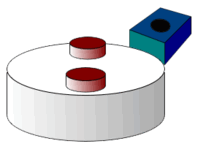
Photo from wikipedia
Enzymatic DNA amplification-based approaches involving intercalating DNA-binding fluorescent dyes and expensive optical detectors are the gold standard for nucleic acid detection. As components of a simplified and miniaturized system, conventional… Click to show full abstract
Enzymatic DNA amplification-based approaches involving intercalating DNA-binding fluorescent dyes and expensive optical detectors are the gold standard for nucleic acid detection. As components of a simplified and miniaturized system, conventional silicon-based ion sensitive field effect transistors (ISFETs) that measure a decrease in pH due to the generation of pyrophosphates during DNA amplification have been previously reported. In this article, Bst polymerase in a loop-mediated isothermal amplification (LAMP) reaction combined with target-specific primers and crumpled graphene field effect transistors (gFETs) to electrically detect amplification by sensing the reduction in primers is used. Graphene is known to adsorb single-stranded DNA due to noncovalent π–π bonds, but not double-stranded DNA. This approach does not require any surface functionalization and allows the detection of primer concentrations at the endpoint of reactions. As recently demonstrated, the crumpled gFET over the conventional flat gFET sensors due to their superior sensitivity is chosen. The endpoint of amplification reaction with starting concentrations down to 8 × 10−21 m in 90 min including the time of amplification and detection is detected. With its high sensitivity and small footprint, this platform will help bring complex lab-based diagnostic and genotyping amplification assays to the point-of-care.
Journal Title: Advanced Functional Materials
Year Published: 2020
Link to full text (if available)
Share on Social Media: Sign Up to like & get
recommendations!